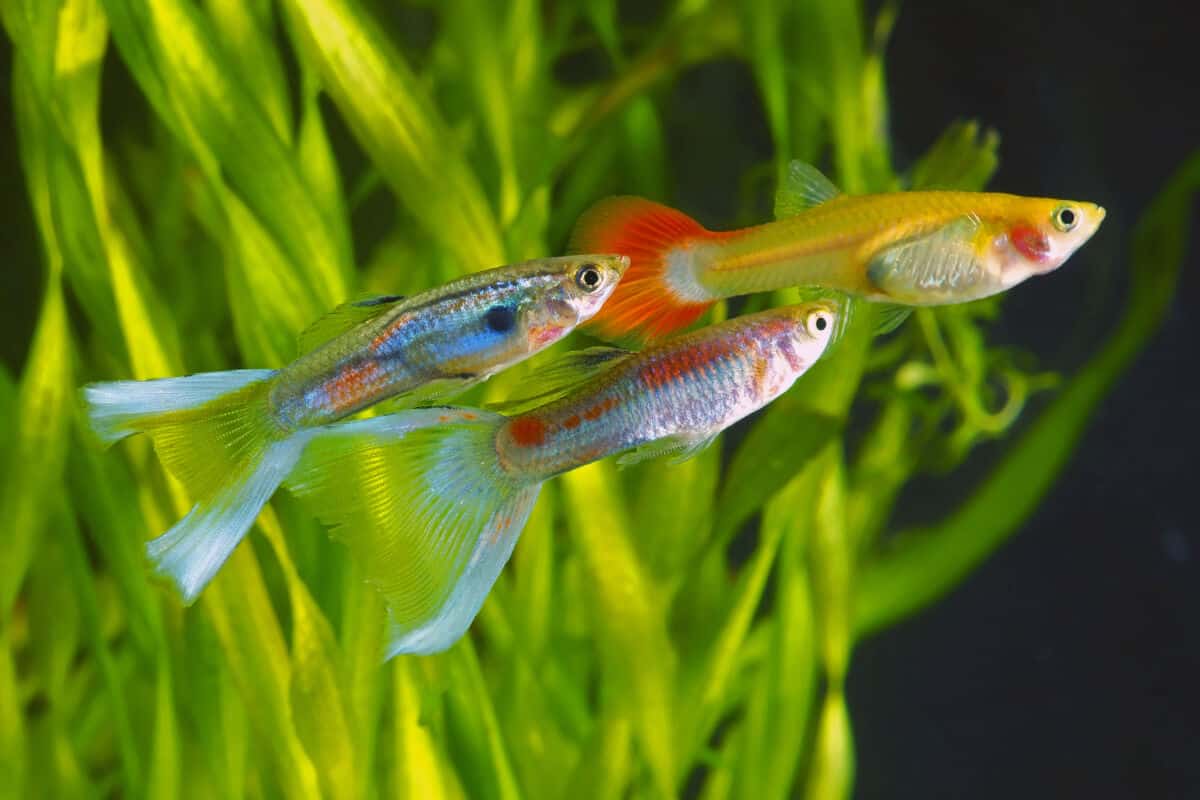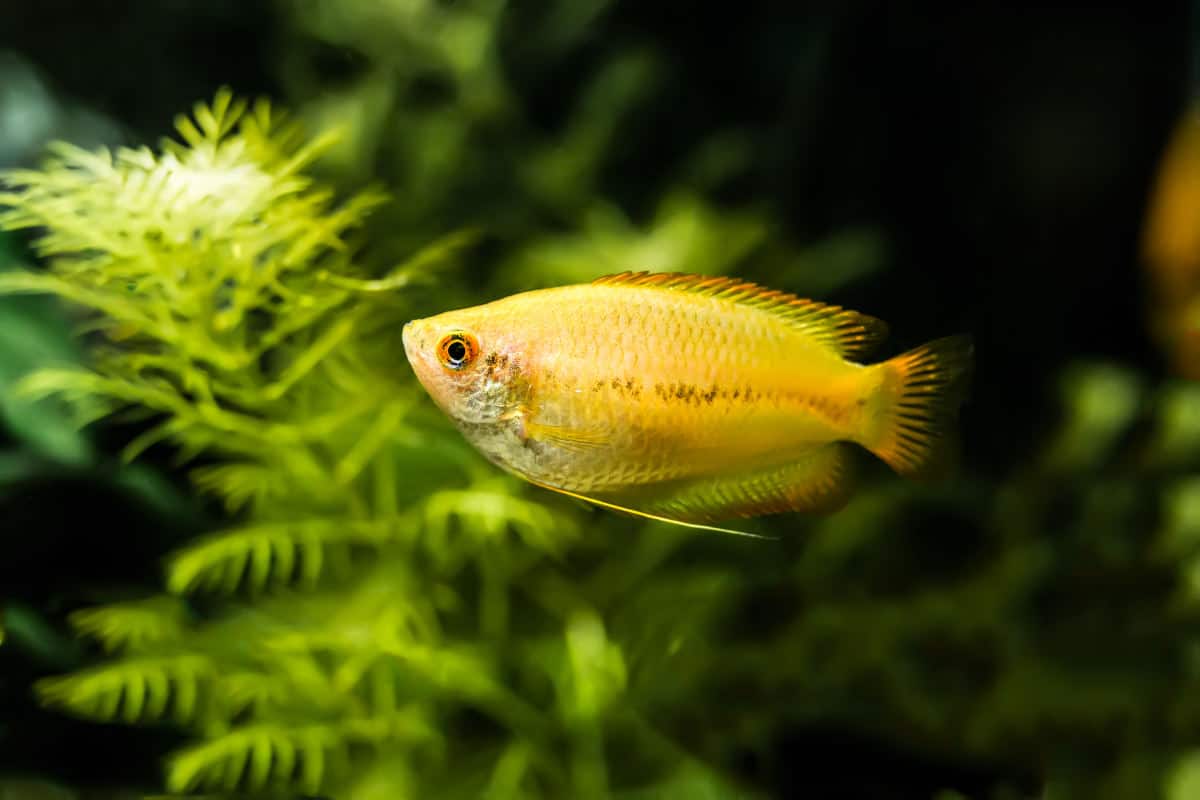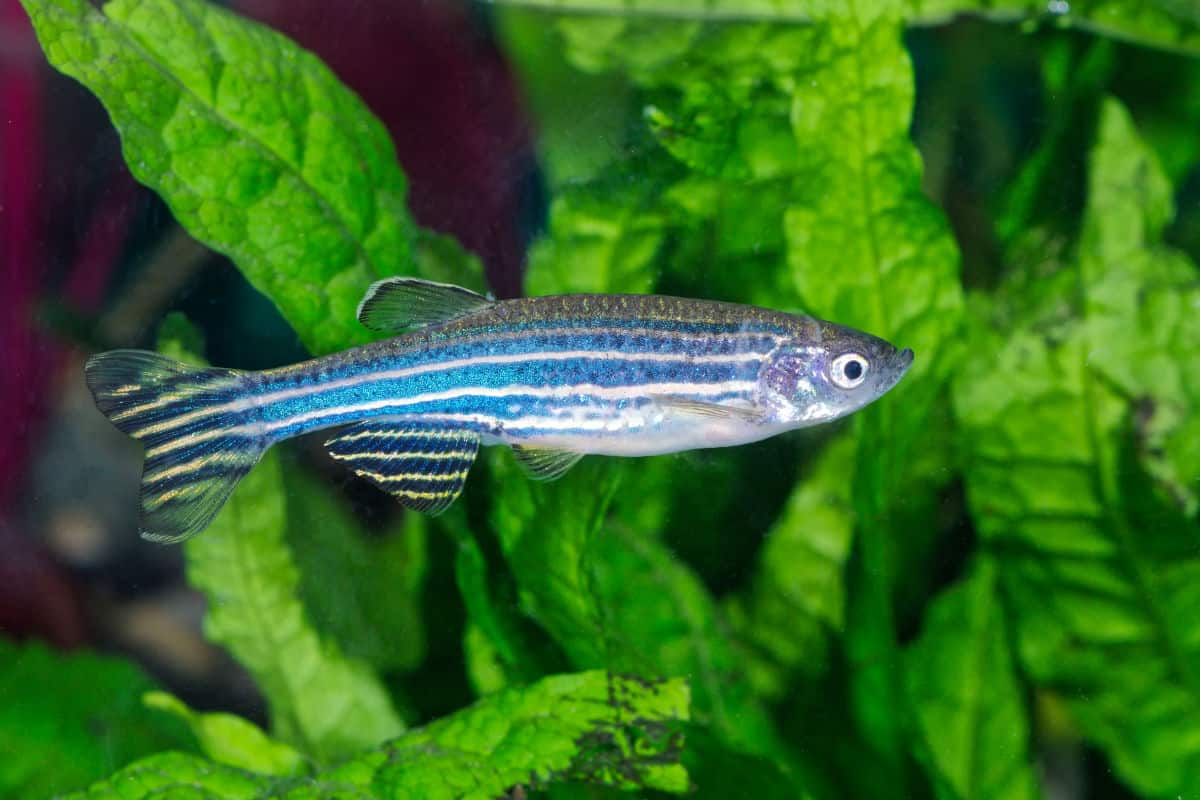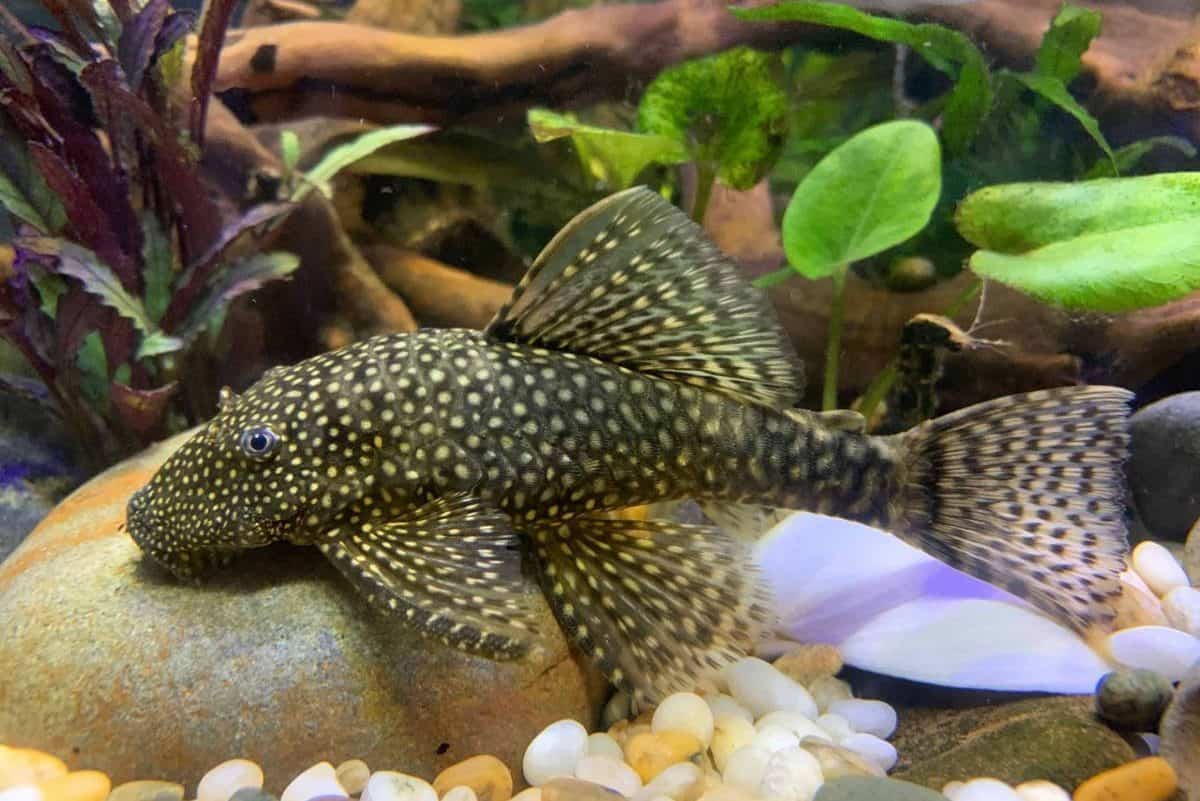Guppies are a popular tropical freshwater fish and one of the most widely available around the world. This makes them ideal for home aquariums, especially if you are a beginner.
In fact, they are a great low-maintenance choice of pet for children, as they are splendidly colorful, bringing vibrancy and character to any aquarium.
Bringing guppies into your home, however, will require both your time and attention. It will mean some short-term and long-term financial commitments, as you invest in a tank, equipment, and food for your guppies.
You will also need to patiently learn all about guppy care, their tank setup and the facts about the types of fish that are living in your midst, since different species differ in their needs.
In this article, we take a deep dive look at guppies breed profile. We share many interesting facts and general information, what they need and how to take care of them properly.
Let’s start by taking a quick look at the most important facts and statistics about guppies; including their general temperament, size, and basic requirements. We will then move on to describe their appearance, guppy care requirements, compatibility, and breeding processes, so you will have a better idea whether they’re the right fish for you.
A Brief Overview
The very first thing you must do when deciding which type of aquarium fish to keep. is take the time to research the most basic, yet important, facts about both the species and the level of guppy care required.
We have made this first step easy for you by creating the following table, which provides a simple overview of guppy facts:
| Characteristic | Details |
|---|---|
| Common name(s): | Guppies, fancy guppy, millions fish, rainbow fish |
| Scientific Name(s): | Poecilia reticulata |
| Family: | Poeciliidae |
| Origin: | Native to Venezuela, Barbados, Trinidad, Northern Brazil and the Guyanas |
| Care Level: | Easy |
| Temperament: | Peaceful |
| Adult Size: | Maximum size 2 inches |
| Color Form: | Guppies can be all different colors, including orange, blue, green, yellow, violet, bronze, red and black |
| Lifespan: | 2–4 years. Rarely 5 or more |
| Minimum Tank Size: | 5 gallons for a trio of guppies, and upwards for more |
| Typical Tank Setup: | Live plants, rocks and substrate |
| Tank Level: | All levels, though may prefer mid and upper levels |
| Diet: | Omnivore |
| Water Conditions: | Freshwater, 64–82° F, KH 10–30, pH 5.5–8.0 |
| Tank mates / Compatibility: | Peaceful and docile and so are compatible with many other similar sized fish. Some examples are Corydoras catfish, Otocinclus catfish, dwarf gourami and snails |
As you can see, the above table highlights how guppies are generally low-maintenance. Overall, they are very easy to care for, which makes them popular in home aquariums with novice to intermediate fish keepers.
There are believed to be as many as 44 different types of guppies. The species are native to Venezuela, Barbados, Trinidad, Northern Brazil and the Guyanas.
They come in various colors and are omnivores, eating most fish flakes and frozen fish food. Males are smaller, but brighter colored than females. They are also livebearers, breed easily and in large numbers.
Appearance: What do Guppies Look Like?
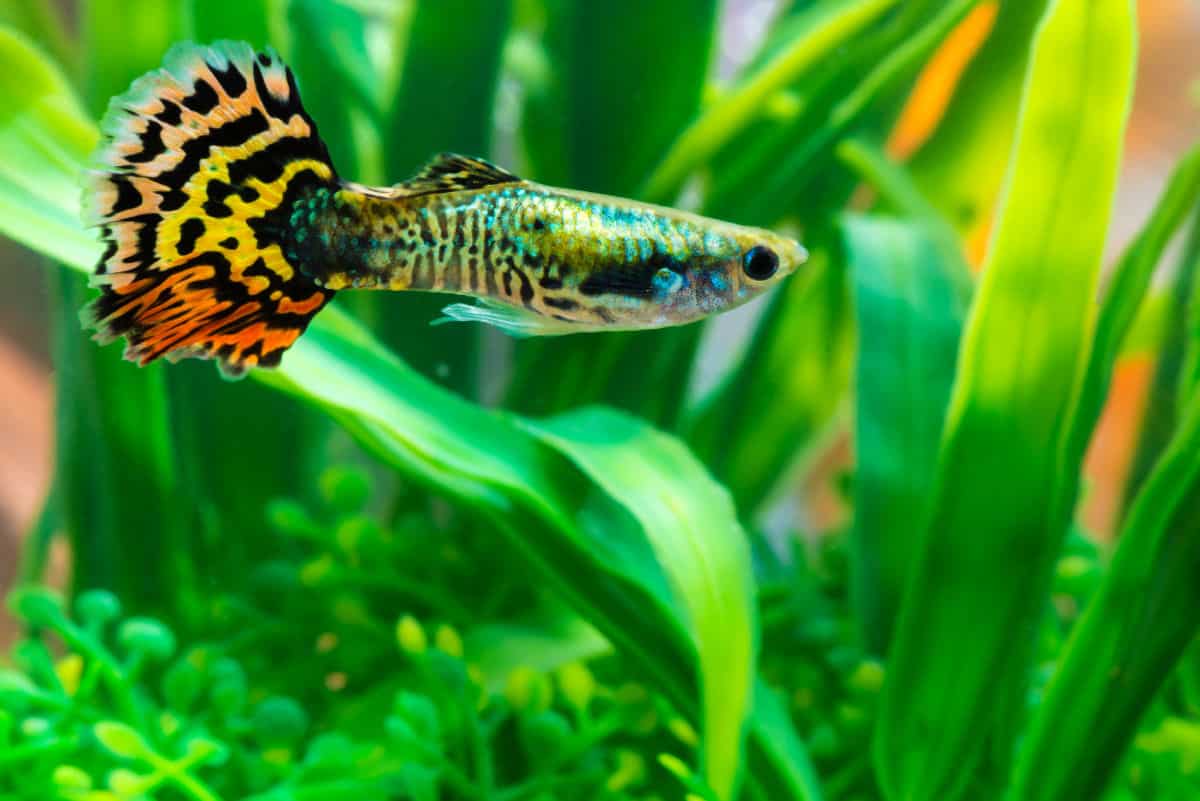
They are perhaps one of the most variable fish when it comes to coloration. They are vibrant, full of character and come in a huge array of colors and patterns. Their tails can be every color imaginable and also come in various different shapes.
Such wide variations are due to flexible genetic markers. Typically, a guppy will begin to develop color on the body between one and six weeks old. Some notable patterns on the body and tail include cobra, snakeskin, leopard, grass, mosaic and lace.
Their fins may also be of various shapes and sizes. These include fan-shaped, triangular, spade, sword, flag and rounded.
This video describes some of the many color variations that can occur by combining gene types.
In the world of home aquariums, they come in various brighter and bolder colors due to such selective breeding techniques. They also occasionally have a translucent quality to the body—this can make it possible to see the fry through the skin of a pregnant female. However, in the wild, females are usually gray, with colorful stripes or spots.
Differences between the sexes are also clear to see. Males are generally smaller and more colorful. In terms of size, they average about 0.6–1.4 inches, whereas females are bigger, at around 1.2–2.4 inches.
What is their Behavior and Temperament?
They are generally mild and easy going. They are incredibly low maintenance, leading them to have been dubbed a “J.A.W” species (just add water).
They are very sociable, which are happiest when kept in small schools. However, if you decide to keep only males to prevent breeding, it’s possible you may notice some aggression between them from time to time.
Despite this, the guppy is generally calm with a peaceful temperament. They also adapt well to variables in water and tank quality and size, making them a very hardy and durable choice. Guppies do not bite but may nibble gently through curiosity.
They are usually very active. They enjoy darting about the tank, swimming up and down and investigating their surroundings. If you find yours are lying on the floor for long periods, it’s possible that they may be unwell.
What is their Ideal Habitat and Tank Conditions?
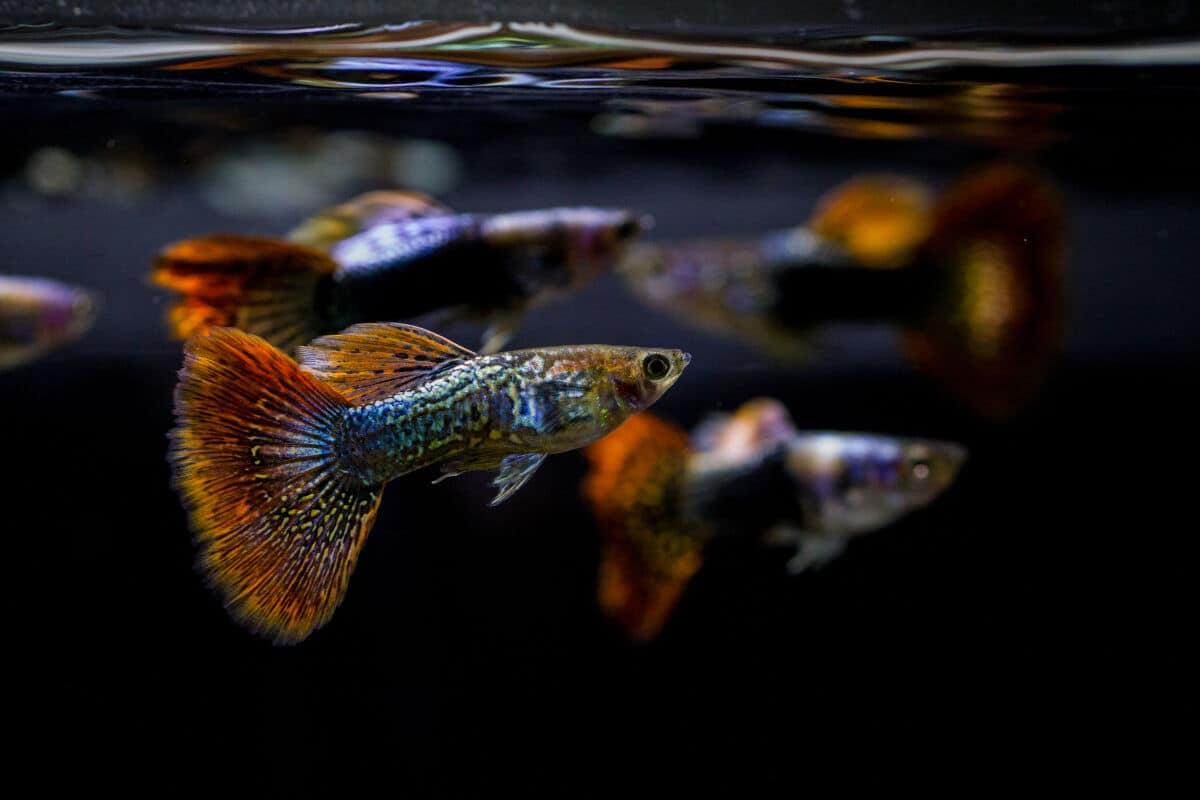
To create their ideal habitat, you have to imagine the warm and tropical freshwaters of South America from which they originate. This is the kind of place you want to create in your home aquarium to ensure that you have a bunch of happy fish!
Having said this, in the wild they are hardy enough to be found in a wide range of water environments. They are usually found in waters that are quiet, with dense vegetation and plant life. This includes canals, warm springs, ponds, and streams.
They are so successful in the wild that they’ve been able to invade most aquatic habitats and thrive.
What Size Tank do They Need?
They need space, as they love to dart back and forth and swim at speed. A 10-gallon tank is ideal for a group of around six with no other tank mates. This gives them lots of space to investigate and swim about without overcrowding.
Water Type and Parameters
You will need to ensure that the water is properly cycled, and a heater is used to keep the temperature at optimal conditions.
The ideal temperature is 68 to 82 degrees Fahrenheit to mimic tropical waters, while the ideal pH range is 6.8–8.5. Water movement should be low, if any.
A guppy is not a brackish water fish, but some salt is appreciated. A small amount (1 to 1.25 teaspoons) of aquarium salt per gallon of water will keep them appropriately mineralized. If you need to replace water that has evaporated, then don’t add more salt.
The way to ensure the tank is thoroughly and consistently heated is to keep the heater on one end, a thermometer on the other, and some current in the water to keep things equal throughout. If the water becomes cold, you may find your guppies become more lethargic.
What Substrate Should I Use?
For a home aquarium, you will probably want to set up a show tank. They are easy and can live with no substrate or different types, so it’s down to personal preference. It’s best to put something, though, as it not only looks better but can reduce stress.
To create an ideal environment you will want to have gravel, sandy or fine substrate for them to poke about in. They like to investigate, and a varied substrate creates an enjoyable home environment.
Filtration Requirements
Good filtration helps maintain suitable water conditions. Filtration systems remove much of the waste and excess food, which keeps the tank clean.
Filters aren’t a necessity as they don’t create much waste. However, if you want to, you can employ the use of a small and simple filter to help keep the water looking its best. Any kind of filter will be fine.
If you choose not to use a filter, be sure to change the water regularly. Around 25 percent, two to three times a month is ideal, though this depends on how many fish the tank holds.
If you have more than four guppies, you may have to change the water once a week.
Lighting Requirements
With regard to light, they aren’t too fussy, happily tolerating all light levels. It’s possible, though, that a strong light from above may damage their coloration over time.
If you are raising fry, be sure to offer around 8 hours of darkness at night, to ensure they get enough rest when sleeping. Lighting the rest of the day will help them to grow faster.
Plants and Decorations
They naturally live in aquatic regions which have a high-density of vegetation. Therefore, they like to have live plants in their environment, such as water sprite and java moss. Some floating fern may also be appreciated.
However, bear in mind that they also like to have the space to be active. So take care not to overcrowd your new friends with too many plants.
How Many Guppies Can I Keep Per Gallon?
They are sociable fish, but hate to be overcrowded. Therefore, try to stick to no more than three per five gallons to keep them happy and healthy. The ideal ratio is two gallons per fish.
Diet and Feeding
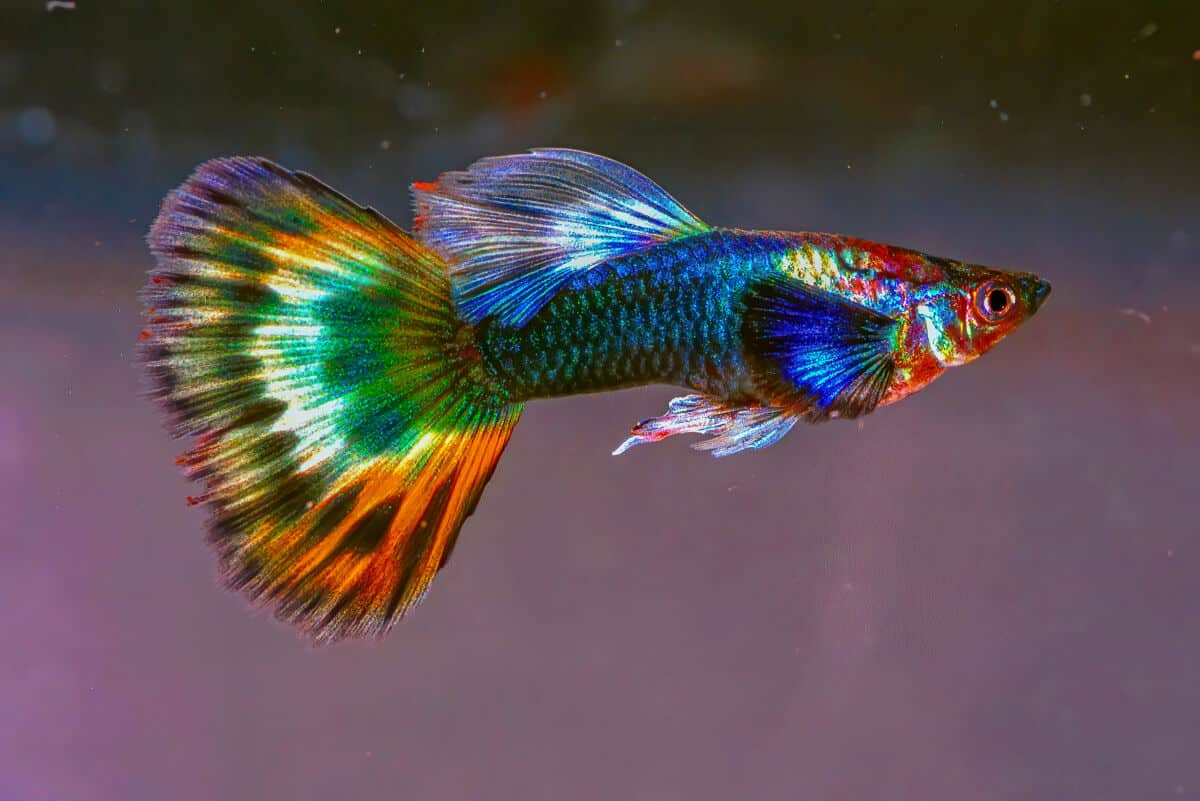
Diet is one of the most important aspects of keeping any fish, and guppies are no different. Fortunately, it’s pretty easy to meet their nutritional needs. In this section, we look at the diet and feeding requirements of this popular species.
What do They Eat in the Wild?
They are omnivores. In the wild they eat algae and the larvae of various insects that are hidden among the vegetation. The majority of their diet consists of plant matter.
What Can You Feed Them in a Home Aquarium?
Because they eat a varied diet, in home aquariums they will accept most fish food and they will gladly eat fish flakes.
You should also try to give them live or frozen foods sometimes. This will help ensure optimal health and appearance.
A study of Trinidadian guppies showed that variations in diet affected the health outcomes of different test groups. So what you feed them will have implications for their experiences.
In fact, baby brine shrimps are a noted favorite, and this can be a regular treat!
What Human Foods Can They Eat?
They aren’t picky easters, so if you fancy giving them a taste of your dinner, they will happily chow down on chopped zucchini, shredded vegetables or cooked peas. Just be sure to remove the skin from the peas before you throw them in the tank.
How Often Should You Feed Them?
With regard to frequency, they need to feed once or twice a day in small amounts. A duration of around 12 hours between feeds will be fine.
Do not feed too much or too frequently. They have small stomachs and overfeeding can cause digestive issues.
Special Care Requirements
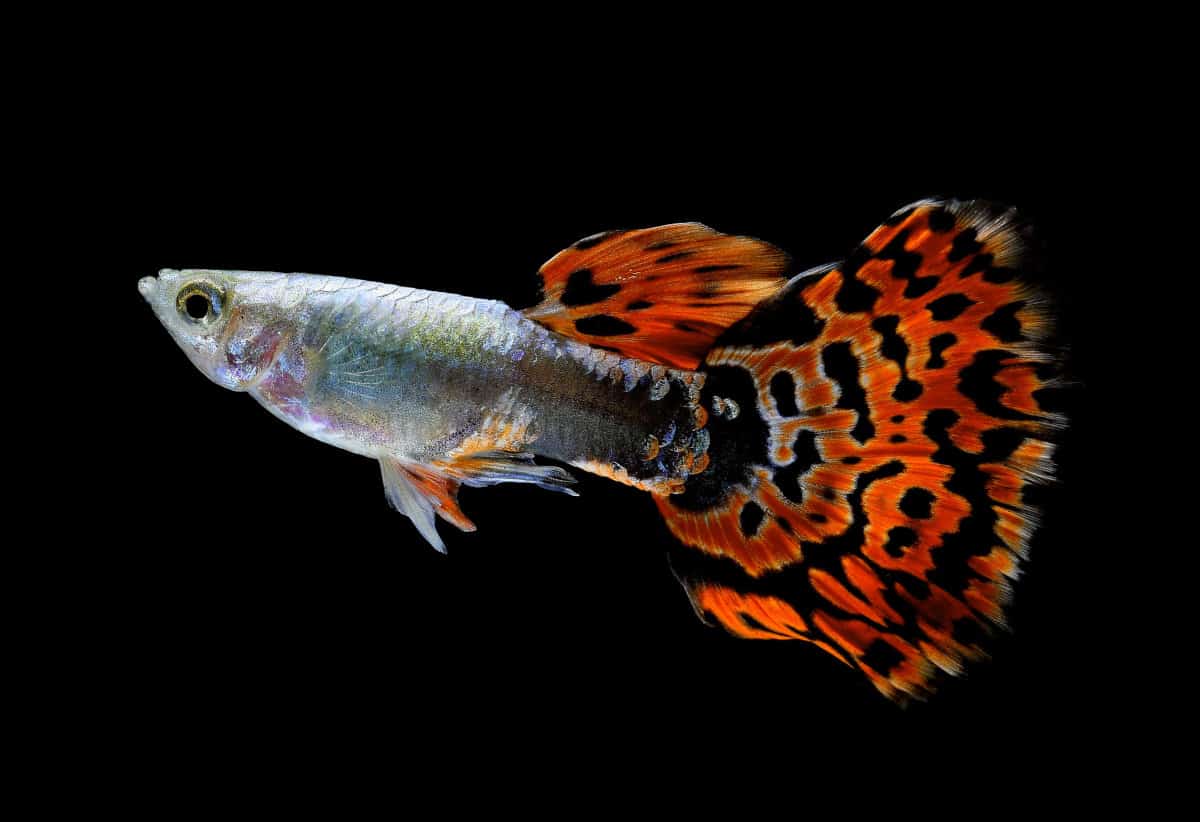
They are generally hardy and durable. The vast majority of them do not need specific environments to thrive.
Simply keep the water clean, change it often, and feed them every day.
If you’re considering combining fish species, you should take care to keep guppies away from fin-pinching species, and larger fish who will likely attack or eat them.
Guppy fry should also be kept separate from the adults (including the parents!) who would otherwise eat them. While this may seem counter-intuitive, it is thought that they do this to prevent overcrowding within the habitat.
Compatibility With Other Fish / Tank Mates
Since they are peaceful, they can live with many other types of fish. They use aquariums at every water level, though preferring mid to high, and tend to live harmoniously in community tanks. This makes them a popular choice for home aquariums.
Sometimes, males will attack other fish that look like them, in order to show off to females. Some good tank mates for guppies are Corydoras catfish, Otocinclus catfish, dwarf gourami and snails.
It is advised not to keep them with fish known to be fin-nippers, such as serpae tetras. Large predatory species such as angelfish should also not be placed in the same tank.
Can You Keep Multiple Guppies Together?
They fare well in groups, with it being possible to keep them in mixed, as well as all-male and all-female groups.
It’s wise to introduce multiple guppies in pairs so that there are no odd ones. Those in male-only tanks sometimes pair up themselves. They occasionally appear to display aggressive behavior, but it is usually harmless.
If you are keeping a mixed tank, then two guppy females for every male is a tried and tested ratio that promises optimal harmony. You may need a backup plan for all the potential breeding in this instance.
They are a gentle and peaceful fish, and fare well in community tanks.
Buying Advice
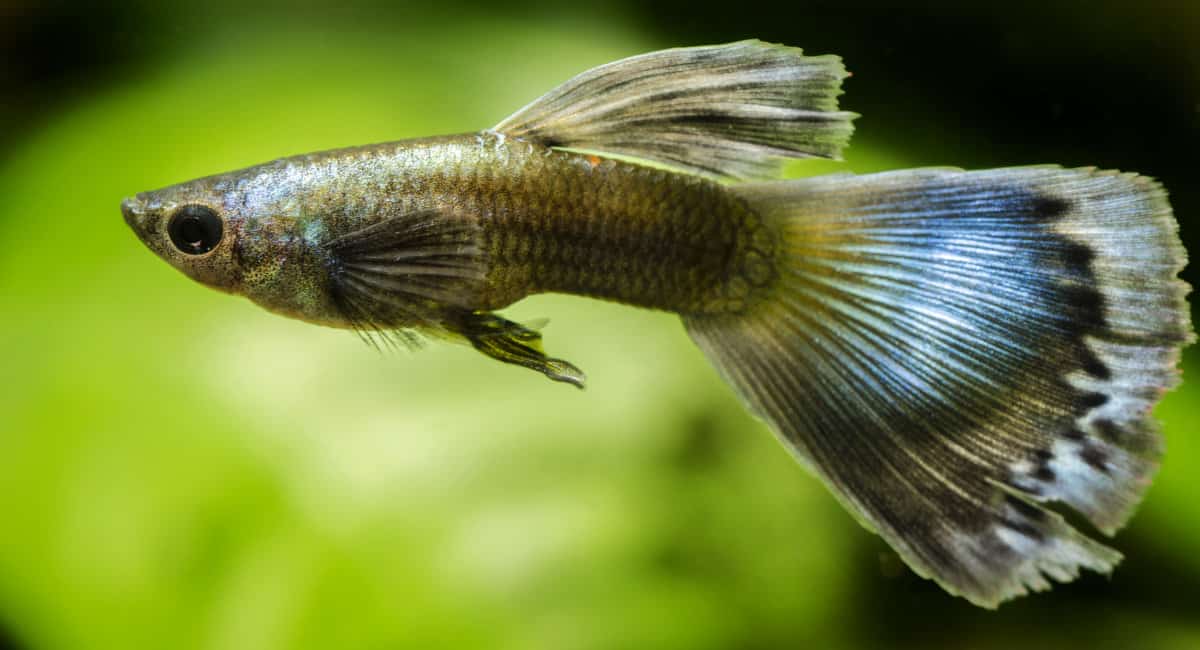
Guppies can be bought from various pet shops, both locally and online. They are usually inexpensive to purchase—starting as cheap as $0.10 to between $5 and $10 per fish, depending on the breed and colorations. Some of the highly colorful ones may cost a little more, sometimes up to $25 or more.
Be aware that mass-produced guppies can sometimes be disease-ridden and low quality. They are particularly prone to fungal infections, especially in their elaborate tails. This presents as red spots on the tail fins.
The more highly glamorous and brightly colored types are also often highly inbred. This can make them subject to genetic conditions that may not be easily spotted upon purchasing. It could affect their lifespan or breeding capabilities.
When buying, look for clear eyes and smooth scales, without roughness, discoloration or flaky skin. They ship well, but it’s always best to purchase in person from a nearby store if you can.
Breeding Tips
They are incredibly easy to breed. They are live-bearers which means they do not lay eggs but give birth to small live fish. These tiny fish can sometimes be seen through the translucent body of the pregnant female before she gives birth.
Guppy females can give birth to around 50 fry a month. In rare cases, this number can even exceed 100. This high numbered breeding is why guppies have also been dubbed as “millions fish.”
If you decide to keep both males and females in a tank together, be prepared to expand your aquarium size! A minimum tank size of 15 US gallons is required for a mixed group of breeding guppies.
Although they breed easily with little intervention, you will need to have a net or enclosed area for the fry once they are born. This is because other fish (including guppies) will eat the fry if they’re not protected.
While selectively breeding guppies can be fun and entertaining, since new colors and patterns can emerge on the baby fish, be aware that too much inbreeding can cause genetic conditions. This will make your newly bred fish lower quality.
Interesting Facts and Trivia
Here are some interesting facts and trivia about guppies to help you win your local pop quiz!
- They have prominent tails which can be veil-, lace-, lyre- or flag-shaped.
- Babies / fry can sometimes be seen through the translucent skin of pregnant females. If you look carefully, you will probably notice the eyes first!
- There are several other names for them: rainbow fish, due to the many colors, and millions fish as they reproduce at a fast rate.
- They are polyandrous, meaning the females have more than one mate.
- Females can produce young all year round since they have the ability to stash sperm for later use.
- They have been used to fight malaria. In 2014, an anti-malaria movement in South India used them to help control the spread of the disease. This is because guppies feed on mosquito larvae.
- Theyare named after Robert John Lechmere Guppy. He discovered the guppy in Trinidad, in the year 1866.
- Today, you can find hundreds of strains and types of guppies. This is due to breeding practices where breeders are continually trying to produce more and more beautiful tails, colors and patterns in these striking fish.
Summary
Guppies are a tropical freshwater fish, native to South America. They have since been introduced to many, if not all, countries around the world.
A guppy is a friendly and low maintenance fish. This makes it an ideal fish for beginner keepers and home aquariums.
Tank sizes don’t have to be too large, with a 10-gallon tank being sufficient for a school of up to 6. The substrate used can be changed to your liking, as guppies are hardy. However, a mix of gravel and sand, with live plants scattered around, is best.
No filter is required, as they aren’t particularly dirty, but the water should be changed regularly, should you choose not to use one.
Guppies are peaceful and are unlikely to attack other fish. Other fin-pinching fish or large predatory species should not be placed in the same tank, since the latter will likely be targeted.
They breed easily and females can give birth to large numbers of fry every month. Their ease of care and various characteristics have led them to be called by a number of common names like rainbow fish, millions fish and even J.A.W (just add water!).
Do you keep guppies? If so, let us know if you have any questions or suggestions regarding our guide on guppy care. We’d love to hear from you!
Happy fish keeping!

